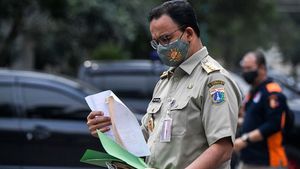JAKARTA - The spokesperson for the Ministry of Health, Mohammad Syahril, stated that the results of the diagnosis of nine patients suspected of contracting Monkeypox or monkeypox in Indonesia were clinically proven to have other diseases.
"Details of the results of the examination of the suspected cases, seven cases were diagnosed negative with orthopoxvirus PCR, one case suffered from bullous pemphigoid and one case of varicella", said spokesman Mohammad Syahril as quoted by Antara, Friday, June 24.
Orthopoxviridae is the virus that causes Monkeypox disease, bullous pemphigoid is the occurrence of fluid-filled blisters on the skin that feel itchy, and varicella which is chickenpox.
Several provinces that reported the development of Monkeypox in Indonesia include West Kalimantan with one case, Central Java with one case, West Java with three cases, and DKI Jakarta with four cases.
"Until today, several regions have reported suspected cases, but based on the results of further investigations, none of them have met the criteria for suspect or probable", he said.
Syahril said the government had facilitated reference laboratories for Monkeypox examinations in Indonesia, including the Primate Animal Study Center, LPPM IPB Bogor, and the Infectious Disease Research Laboratory Prof. Sri Oemiyati Warehousing Complex of the Ministry of Health Building 01, Jakarta.
Syahril who also serves as Director of RSPI Sulianti Saroso said Monkeypox is a zoonotic disease that was first discovered in Denmark in 1958. At that time there were two cases of smallpox that appeared in monkeys kept for research activities called Monkeypox.
Monkeypox was transmitted to humans for the first time since 1970 in the Republic of the Congo. Then it becomes endemic in West Africa and Central Africa, namely Cameroon, Central African Republic, Nigeria, Ivory Coast, Liberia, Ghana, Sierra Leone, Gabon, and South Sudan.
Since May 13, 2022, 28 non-endemic countries have reported Monkeypox, including 1,536 suspected cases in Africa and 1,285 confirmed cases in Europe, America, and Australia.
According to Syahril, the incubation period for Monkeypox ranges from 5-13 days or 5-21 days after contracting. There are two incubation periods, namely the invasion period of 0-5 days, high fever, severe cephalgia, lymphadenopathy, myalgia, and asthenia.
Next is the eruption period ranging from 1-3 days after experiencing a fever and a rash occurs on the skin. "The rash is 95 percent of the face, 75 percent of the palms and soles, 70 percent of the mucosa, 30 percent of the genitals, 20 percent of the mucous membranes of the eyes.
"Monkeypox will heal by itself in two to four weeks", he said.
According to Syahril, the groups most vulnerable to contracting come among children, aged 40-50 years and immunocompromised sufferers or those who experience problems with the immune system.
Complications that may occur are secondary infection, bronchopneumonia, sepsis, encephalitis, corneal infection, causing blindness.
SEE ALSO:
Syahril added that Monkeypox can be transmitted from animals to humans when there is direct contact with the blood of monkeys, rats, and squirrels. Body fluids are also a medium of transmissions such as skin lesions or mucosal lesions from infected animals.
"Meat from infected wild animals, or bush meat, can also be a route of disease transmission", he said.
Meanwhile, human-to-human transmission occurs when there is direct contact with blood, body fluids, or skin or mucosal lesions. "It can pass through the respiratory tract during close contact for a long time, such as bites, scratches, and others", he said.
In addition, said Syahril, Monkeypox transmission is also possible from mother to baby through transmission via the placenta.
The English, Chinese, Japanese, Arabic, and French versions are automatically generated by the AI. So there may still be inaccuracies in translating, please always see Indonesian as our main language. (system supported by DigitalSiber.id)















